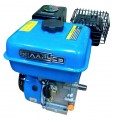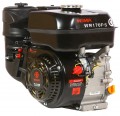Power
The rated power of the engine in horsepower (in fact,
the maximum power that the unit can produce in normal operation, without overloads). Despite the popularity of the designation in watts (see below), horsepower (hp) is still quite widely used to indicate the power of internal combustion engines. 1 HP is approximately 735 watts.
In general, the more powerful the engine, the more speed and tractive effort it is able to develop. On the other hand, this indicator directly affects the weight, dimensions, and most importantly, the cost of the unit, while the real need for high power is relatively rare. Therefore, it is worth choosing according to this indicator, taking into account the features of the planned application; specific recommendations on the selection of an engine for a specific technique and tasks can be found in special sources. We only note that models of the same power can differ in speed and "torque"; see "Shaft speed" for details.
In general, performance up to 8 hp. are considered low, up to 13 hp. — medium, more than 13 hp — high.
Power
The rated power of the engine (the highest power it can deliver in normal operation) in kilowatts. Initially, the power of internal combustion engines (ICE) was usually denoted in horsepower, but now it is also common to record in watts / kilowatts; this, in particular, makes it easier to compare the power of internal combustion engines and electric motors. Some units can be converted to others: 1 hp approximately equal to 0.735 kW.
In general, the more powerful the engine, the more speed and tractive effort it is able to develop. On the other hand, this indicator directly affects the weight, dimensions, and most importantly, the cost of the unit, while the real need for high power is relatively rare. Therefore, it is worth choosing according to this indicator, taking into account the features of the planned application; specific recommendations on choosing an engine for a specific technique and tasks can be found in special sources. We only note that models of the same power can differ in speed and "torque"; see "Shaft speed" for details.
Shaft type
Shaft type, more precisely, the type of fastening for the hub provided on the shaft shank.
Recall that a hub is a part with a hole that is put on the shaft; it is through this part that the rotation is transmitted to the mechanism with which the engine is used. The general rule in this case is this: the type of shaft must match the type of mounting on the hub, otherwise normal operation will not be possible. Nowadays, there are units with shafts
under the key,
under the spline,
under the cone and
under the thread. Here is a more detailed description of each option:
— Dowel. Connection using a key — an elongated part placed in a special longitudinal groove. More precisely, there are two grooves: one is located on the shaft, the other is on the hub, and the key is tightly installed in the space formed by the grooves and connects the shaft and the hub. Such connections are simple and at the same time quite functional, due to which they are widespread and found in engines of all price and “weight” categories. On the other hand, a keyed connection is less secure than a splined connection and is less suitable for high RPM and/or heavy loads.
— Slots. Connection based on slots — longitudinal slots. Most often, there are six of them on the shaft, and the seat on the hub has the appropriate shape — in the form of a charac
...teristic asterisk. A spline connection is more complicated and more expensive than a keyed connection, and numerous slots reduces the strength of the shaft and it has to be made thicker. However, the connection itself is very reliable, as it evenly distributes the load during rotation. Therefore, splines are recommended for work at high loads.
— Cone. A shaft with a shank in the form of a cone (tapering towards the end), in the centre of which there is a hole with an internal thread. It is used quite rarely, mainly on fairly powerful units — from 7 hp. and higher.
— Carving. Cylindrical shank with external thread. A rather specific option that has not received much distribution — in particular, due to the fact that the thread tends to loosen from vibrations as it is used, and significant efforts may be required to connect and disconnect the shank and hub.Shaft length
It is customary to call the shaft length only the length of its outer part protruding beyond the engine housing. The optimal value of this parameter depends on the characteristics of the machine in which the engine is planned to be installed.
Shaft diameter
The diameter of the motor shaft, more precisely, the diameter of its outer part, located behind the housing. Data on the diameter of the shaft is needed to clarify the compatibility of the engine with the mechanism for which it is bought.
Now on the market there are shafts with the following diameters:
16 mm,
19 mm,
20 mm,
22 mm,
25 mm.
Capacity
The working volume of all engine cylinders. Usually, other things being equal, a larger volume allows you to achieve higher power, but increases fuel consumption and affects the dimensions of the unit.
Piston stroke
The distance that an engine piston travels from one extreme point to another. In general, it is a rather specific characteristic and is rarely required in fact (for most ordinary users, it is never needed at all in the entire “life” of the engine).
Fuel tank volume
The nominal volume of the engine's fuel tank is the maximum amount of fuel that can be safely filled there. Knowing the fuel consumption (see below), it is possible to estimate the operating time of the unit on a single refill by the volume of the tank by dividing the tank capacity by the consumption.
Large fuel tanks, on the one hand, allow you to work for a long time without refueling, on the other hand, they significantly affect the dimensions and weight of the engine. Also note that many models allow refueling "on the go." When choosing a tank volume, manufacturers take into account these points, as well as the “weight category” and the specifics of the engine application.
Crankcase oil capacity
The regular volume of oil in the crankcase, in fact, is the amount of oil necessary for the normal operation of the unit (some deviations are allowed, but only within small limits). This parameter allows you to estimate how much oil is required to fill or refill the engine lubrication system.

